Using popped-up pike baits
Predator ace Mick Brown increases his chances of catching by making his bait more visible. We look at pop-up piking tactics...
Even in the depths of winter, a heavy weedbed won’t die back completely. This is when a popped-up deadbait comes into its own.
Using a standard leger rig will see the bait dragged into the weed and out of sight.
It is true that as well as their other senses, pike have an exceptional sense of smell and will eventually find any bait in the water, regardless of how buried in weed it may be.
However, to tilt things further in your favour and speed up times between runs, using a popped-up deadbait will allow any patrolling pike to spot your bait a lot quicker.
Furthermore, similar to carp anglers who use pop-up boilies to alter their rig presentation, there are times when pike prefer a popped-up bait as opposed to a standard deadbait offering where the bait lays lifeless on the bottom.
The beauty of a popped-up deadbait, particularly on large waters where there is a strong undercurrent, is that the bait will flutter enticingly.
To exaggerate this swaying movement, you can drag the bait back a few turns every few minutes to try and induce any pike in the area to make an attack.
This movement can be very appealing to pike, who primarily use sight for hunting purposes for much of the time. They are also one of the only freshwater fish to have binocular vision. This means their eyes see things very much like our own.
The advantages of binocular vision means the pike will still have a spare eye if one is damaged, allowing it to continue feeding.
Also, binocular vision gives the pike precise depth perception – ideal for exact judgment of distances which is an invaluable asset for a predator that primarily hunts by ambushing its prey.
To further enhance the visual stimuli, Mick quite often colours his deadbaits using one of Dynamite Baits’ new pike flavourings.
One of his favourites is red. “All predators love red. By painting my deadbaits this colour it gives me confidence and I’m positive that it also brings a few more pike than a standard popped-up bait might otherwise do,” he said.
HOW TO MAKE A POP-UP TRACE LINK
There are many ways to popup a deadbait. Some anglers use large hi-density foam popup balls, inject the bait fish itself with air, or insert a length of buoyant material – foam sticks or balsa sticks.
Mick prefers the later – buoyant balsa sticks – for popping up his deadbaits.
He feels that using a Fox Predator Floater Stick is the safest way to pop-up a bait for both the angler and the pike.
The beauty of pop-up sticks is that they have a tiny moulded eye in the top of them. This allows Mick to attach the stick to a short length of trace wire, before the stick is pushed into the cavity of the deadbait.
Once the bait is taken, there is no way that the pike can bite off the link and swallow the stick because the pop-up stick is attached to the trace via a length of trace wire.
“When it comes to making pop-up links, I like to standardise the length of the trace that I attach the pop-up stick to,” Mick explained. “By making every pop-up link the same length – four inches in my case – you can then buy baits of suitable size that can be either hooked on whole or cut down to the perfect length required.”
Another tip from Mick is that he likes to keep a handful of pre-made links in his tackle box, to be used whenever he needs them.
“The trouble with a lot of anglers is that we’re lazy, and even though we know that tying a certain rig will probably bring more bites, we can rarely be bothered to do it on the bank.
“By having a few pre-made pop-up traces already in my tackle box, there are no excuses,” Mick added.
To make one of Mick’s pop-up traces (see sequence, right) you will need:
● A rig trace to mount the deadbait on
● 20lb Carbo Flex trace wire
● Crimps
● Crimping pliers
● Trace blades
● Fox Sea Lead Clips
● Forceps
● Fox Predator Deadbait Floater Sticks
● An appropriately-sized deadbait
STEP ONE
This is all the kit you need to fashion one of Mick Brown’s deadbait pop-up links – (from left) crimps, trace blades, crimping pliers, Fox Deadbait Floater Stick, Fox Sea Lead Clip and a spool of 20lb Carbo Flex trace wire
STEP TWO
First, snip off an eight-inch length of Carbo Flex wire using the trace blades
STEP THREE
Next, thread on a crimp and the Fox Sea Lead Clip then take the tag end and pass it back through the crimp to form a half-inch hoop. Then squeeze the crimp into position using the pliers. This locks the lead clip in the loop
STEP FOUR
Mick then threads on another crimp at the other end of the trace wire, making another loop so that the distance between this loop and the end of the lead clip is four inches. The new crimp is then locked into place with pliers
STEP FIVE
The loop (without the lead clip) is then threaded over all three points of the top size 6 treble hook on the pike trace
STEP SIX
Make sure that the size of Fox Deadbait Floater Stick you plan to use matches the size of bait
STEP SEVEN
Use a pair of forceps to enlarge the cavity of the deadbait into which the floater stick will be inserted
STEP EIGHT
Having pierced the tail end of the fish (see step seven), the lead clip is inserted into the fish’s rear vent and the wire link is then pulled through using the forceps. Alternatively, use a carp angler’s stringer needle to pull the link through
STEP NINE
Fix the lead clip on to the floater stick via the metal loop in the end of the stick
STEP 10
The stick is then inserted into the bait – just be careful not to split the deadbait
STEP 11
The top treble goes into the root of the deadbait’s tail...
STEP 12
...and the bottom treble of the pike trace goes into the deadbait’s flanks
STEP 13
Before adding flavour pierce the sides of the deadbait to ensure that the flavour penetrates the flesh
STEP 14
One of Mick’s favourite flavours is the new Dynamite Baits’ Predator Blood Red which both colours and flavours
STEP 15
The red flavour is painted on and left to dry for a few minutes before it’s cast into the swim. Once settled in the water, it will stand proud of the bottom.
The best deadbaits to use when fishing for pike
Fish are the main diet of pike, catfish, zander and big eels. The feed naturally on both live and dead fish of many species, so it makes great sense to use deadbaits, in their many forms, to catch these fish.
Sea or coarse fish deadbaits?
The choice as to which you should use will probably not be yours as the controlling club of the water you are fishing may well state that coarse deadbaits aren’t allowed, and probably neither are livebaits.
This ruling will have been placed to protect the natural coarse fishing population of the lake or waterway. It will prevent their smaller fish from being caught and killed to be used as bait, but more importantly it will prevent anglers introducing strains of virus from fish of one water to another.
But, if the fishery rules allow you to use either sea or coarse fish deadbaits here’s what we suggest you do… When targeting pike, sea deadbaits are often the best choice. For zander, eels and catfish, coarse deadbaits seem to work better.
Types of sea deadbaits
There are more choices of sea deadbaits than there are coarse fish deadbaits, plus they are often more readily available. You will be able to buy them pre-packed and frozen at all good fishing tackle shops, but equally they are for sale in all good supermarkets too. Here’s details of the most commonly used sea deadbaits, and why.
Which ever type of sea deadbait you intend using, you must hook the baits correctly. The very last thing you want to happen on a cold winter’s day, when the pike aren’t going to eat much, is for your deadbait to fly off the hook to provide the pike with a free meal!
Mackerel
This is a fantastic sea deadbait for many reasons. It’s skin is very tough, it can be cut into small sections and literally carved with a sharp knife to make it aerodynamic, and it is quite weighty for its size, therefore mackerel can be cast a heck of a long way with a 2.75lb or 3lb test curve specialist rod.
They are incredibly oily fish too, so their scent trail carries a long way in the water.
If you can only get hold of 10-12in long mackerel in your local supermarket, don’t worry. You do not have to use them whole and face the possibility of smashing your rod to pieces upon the cast. Get a very sharp knife and cut them in half using a diagonal cut. A lot of predator anglers prefer to use the tail section and we understand why – because it’s the most aerodynamic – but the head section leaks more blood and scent, so it’s swings and roundabouts, really.
Smelt
This is another firm favourite among predator anglers because of the strange smell of the smelt, plus it’s size makes it perfect for fishing with. The smelt smells of cucumber.
They are long and lean sea fish that aren’t often seen in supermarkets or fishmongers – you will have to buy them from your local tackle shop.
They are quite soft fish, but with careful hooking you will be able to cast a whole smelt a good long way.
Herring
Herrings are available from good supermarkets as well as tackle shops. They are regarded as one of the better sea deadbaits for pike fishing because of the huge amount of oil that the fish releases.
They are fairly substantial sized baits when used whole, so the best way to use a herring is to hook it in the tail root and the back, then take a very sharp knife and slice the bait diagonally, half-an-inch beyond the second treble hook. Doing this not only makes the bait easier to cast due to its weight being reduced and it becoming more aerodynamic, but it also helps to release all those lovely juices into the water.
Sprats
These are very small deadbaits that can easily be used whole. They are very light, so when they are used with a fairly heavyweight rig they can be cast great distances quite easily. They tend to measure only 4-6in.
Sprats are very slender sea fish that can be bought from fishmongers as well as tackle shops, but you are more likely to find them in supermarkets.
They are quite soft when they are fresh, so bait floss may be necessary to tie the bait to the hooks when you need to cast them good distances.
One of the best uses for sprats is as an attractor. As they are so cheap it’s not too much of a burden on the back pocket to chop them up and feed them into your swim to attract those pike.
Lamprey
This eel-like species is actually a sea fish. It spends most of its time in the sea and will only move into estuaries and then into freshwater to spawn. And as the fish spends the vast majority of its life at sea, we think it can be classed as sea bait.
It is a terrific bait though. Because the lamprey feed upon the blood of other sea species, it is absolutely full of the stuff. A fresh or recently thawed lamprey will ooze masses of blood, producing a very long scent trail that predators will soon sense.
They are available from all good tackle shops (you won’t find them for sale at supermarkets) and they have very tough flesh that allows them to be cast enormous distances if needed.
Other sea baits
There are other sea baits that anglers use when those pike have become wise of the usual baits. Fish such as sardines and sandeels can have their day, and even squid can catch pike.
Sardines and sandeels are best fished static as they are quite soft-fleshed fish so constant casting and retrieving associated with wobbling will soon see the baits fly off the hook.
A whole squid, on the other hand, has tough enough flesh to allow it to be hooked and re-cast numerous times for wobbling. The white flesh and many tentacles make this bait unbelievably attractive to any nearby pike.
Popping up your deadbaits for extra visibility
Whether they are frozen or defrosted, deadbaits sink like a stone. This is hardly ideal as there may be times when you are fishing over a thick bed of weed or a thick layer of fine silt – the deadbait may become entangled in the weed or it may sink right out of view.
The way around this is to pop the deadbait up so it remains visible and snag-free at all times.
What you will need
To do this effectively you will need a pair of forceps, some wire, a baiting needle, wire cutters and either one or two red, buoyant Fox Bait Poppers. The amount of Bait Poppers you use will depend upon the size of the deadbait you are fishing with. The larger the bait, the more poppers you will need.
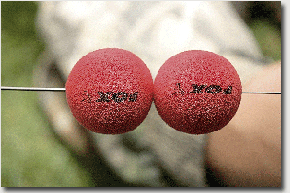 |
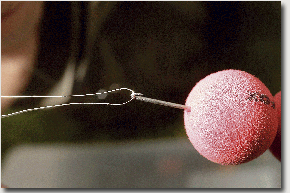 |
|
|
STEP 1 |
STEP 2 |
|
 |
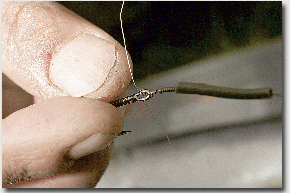 |
|
|
STEP 3 |
STEP 4 |
|
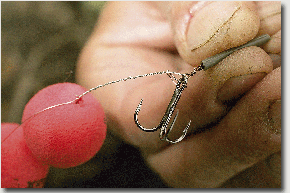 |
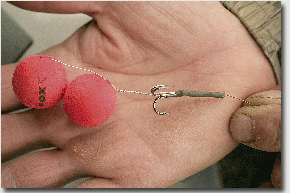 |
|
|
STEP 5 |
STEP 6 |
|
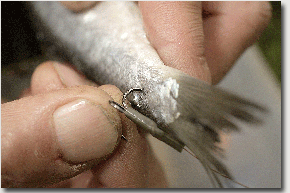 |
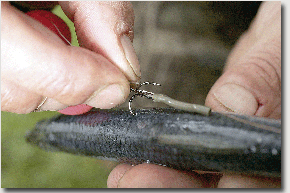 |
|
|
STEP 7 |
STEP 8 |
|
|
|
Here's the finished pop-up rig. The bait will sit up, on top of the weed, begging for a pike to snap it up. |
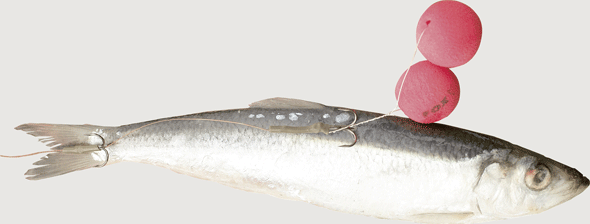
Flavouring deadbaits for pike fishing
Many deadbaits ooze oils and blood, but it is possible to flavour deadbaits to make them even more attractive.
Although there aren’t that many flavourings out there that cater for the predator angler, there are enough. Most specialist fishing tackle outlets stock them, and one of the most popular in recent years has been Predator Plus – a red liquid that pike seem to love.
The best way to flavour deadbaits is to inject them. This forces the flavouring right inside the bait, making it leak into the water steadily for a long time.
As the vast majority of deadbait flavourings available are oil-based, using a very fine needle with your syringe isn’t ideal. The needle will become blocked very quickly and unusable.
The best thing to do is to invest in a deadbait injecting kit, comprising a large syringe and a very wide bore needle. This will allow you to inject those oily additives easily and quickly.
Injecting your deadbaits
Adding extra scent and attraction to your deadbaits is easy, but you must take care. Firstly you need to defrost the deadbait fully or it will not take on any of the injected additive.
Once defrosted place the deadbait on the ground, not in your hand. If you slip and inject yourself accidentally you will suffer all manner of possibly fatal complications.
Fill the syringe with the required amount of additive, push the needle onto the end of the syringe, pierce the deadbait deeply with the needle and squeeze a little additive into the fish.
Do this as many times as you like, piercing the bait and squeezing a little additive into the hole formed.
Once in the water the additive will seep from the fish and be carried along with any flow or undertow where it will arouse the interest of a nearby predator and they will follow it right to your bait.
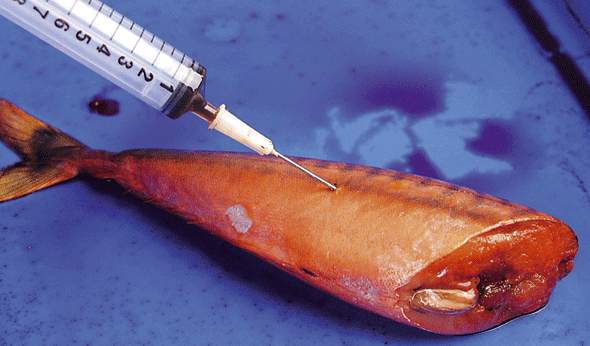
How to hook deadbaits when pike or zander fishing
There is a very simple method to hook deadbaits to ensure they not only stay on the hook throughout a powerful cast but it also ensures that the hooks are in a prime position to ensure that they hit home and the predator is landed.
Correctly created wire pike rigs will have two sets of treble hooks, one positioned at the end of the wire, and another set around 2-3 inches along the wire.
The treble hook that is locked along the wire should be set securely within the tail root of the deadbait. It must be locked as tightly as possible within the bait as this hook takes the most pressure upon the cast.
The treble hook that is positioned at the end of the wire trace should be lightly nicked into the flesh of the back or side of the deadbait.
If you are using semi-barbed treble hooks where two of the three points are barbless, make sure you insert the barbed point into the deadbait as this hook will grip the bait much firmer than the barbless hooks.
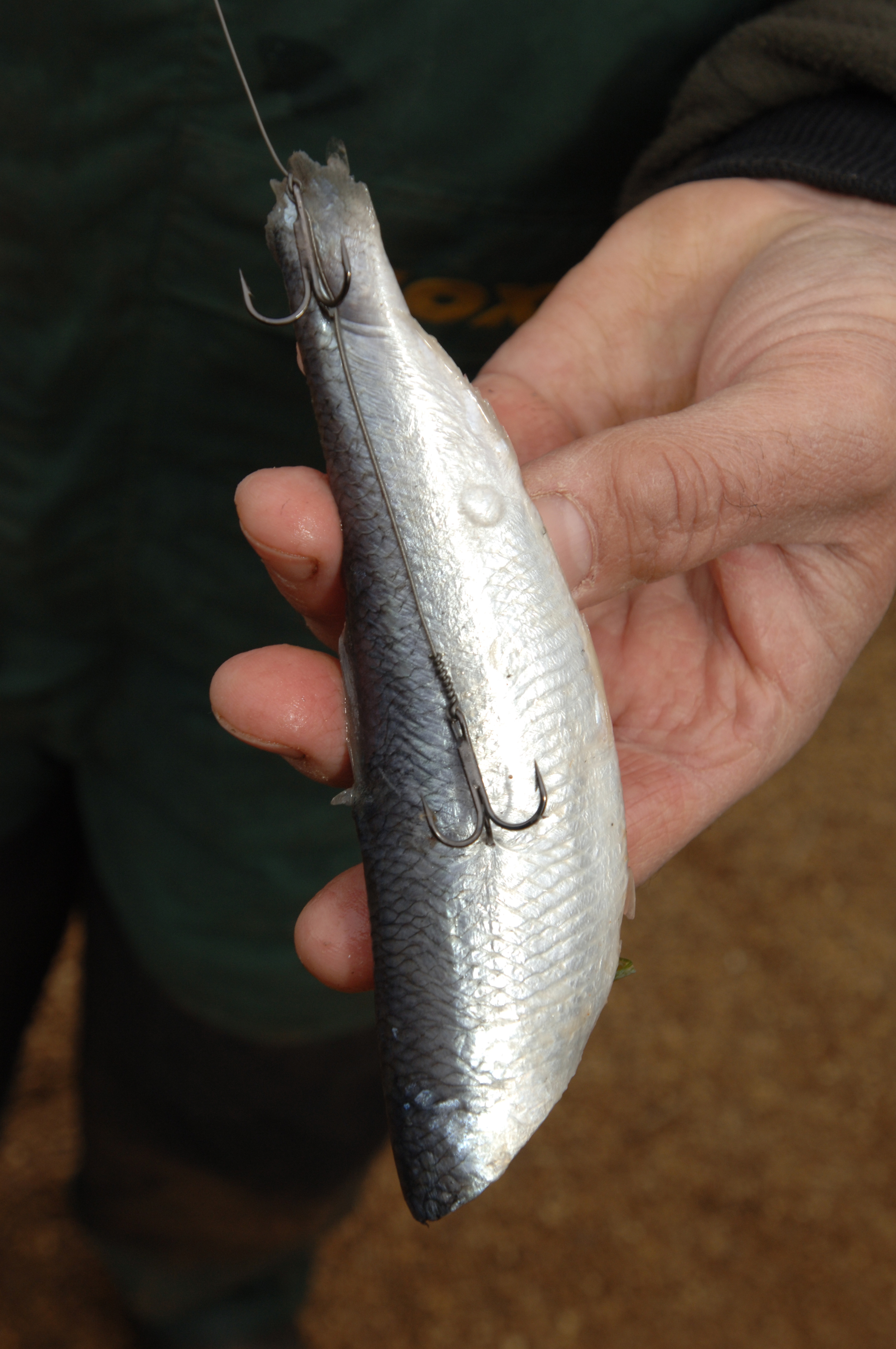
Colouring deadbaits
If you want to make your deadbaits even more attractive to any passing pike you could colour them. This will also trick wise pike into taking baits that would otherwise reject.
To colour deadbaits you will need a lot of newspaper, some forceps, some kitchen paper, an old bait box and your chosen dye.
The best dyes to use are those that carp anglers use for colouring boilies. They are extremely potent and, when added to a little water, provide a great deadbait dye.
Mix a spoonful of colouring with a cupful of water in your bait box. Now use the kitchen paper to dry your deadbaits as much as possible.
Grip your deadbaits by the tail with your forceps and swish them around the dye until the whole body becomes coloured. Once dyed, leave the baits to dry on the newspaper (try not to drip the dye any anywhere that may stain). The dried baits can be wrapped in cling film and frozen for later use.
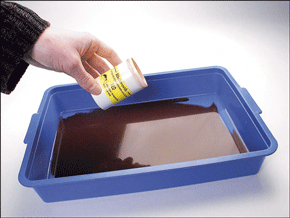 |
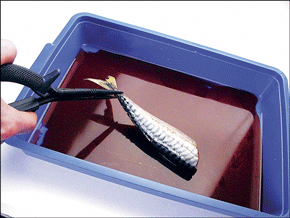 |

























